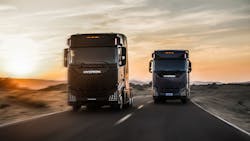When working for autonomous vehicle (AV) company TuSimple, co-founder Mo Chen and head of marketing Jason Wallace discovered that AI software was not the only barrier to AV adoption. A lack of ready-made autonomous trucks meant providing autonomous solutions at scale would be a challenge. A year and a half ago, Chen and his team began working to create hardware for autonomous trucks, the efforts of which led to trucking startup Hydron.
Between a perennial driver shortage and increasing environmental regulation, the trucking industry has no shortage of hurdles. Hydron's hope is that it can tackle both of these problems by offering a double solution in its hydrogen AVs, increasing efficiency for both emissions and freight handling simultaneously. The company has plans to establish a factory in North America, with the first generation of trucks predicted to enter mass production in the third quarter of 2024.
FleetOwner talked to Wallace, a former TuSimple employee and Hydron's head of North American operations, about how his experience with TuSimple translates to Hydron, speculation on the emerging AV/EV market, and the technological, commercial, and regulatory barriers Hydron must overcome to achieve the company's goal.
(Editor’s note: The following Q&A has been edited for clarity.)
FleetOwner: What is the vision for this company?
Jason Wallace: The vision for this company is to offer hardware to the marketplace to support both autonomous activities and clean propulsion. We discovered that one of the biggest challenges was not in scaling and developing the software, it was actually access to the hardware. We were working with a lot of the OEMs like Navistar, Paccar, etc., and it became clear that a lot of the timelines, a lot of the availability on committing to volumes—the hardware that was going to be required to put these autonomous trucks on the road was really a bottleneck. It's meant to alleviate the bottleneck that exists for both autonomous driving companies and for large fleets that are looking for not just autonomous trucks, but autonomous trucks that are also driving clean propulsion systems.
FO: Why are you going with hydrogen fuel cells as opposed to battery-electric vehicles?
JW: Autonomous trucking is best suited for long-haul applications. They travel along pre-mapped routes, mostly highway. That's where you see a strong ROI. One of the limitations with battery EVs is that it's just not at a level where it can support the long-range applications.
FO: What are you doing to build infrastructure?
JW: We intend to do business with large commercial fleets and autonomous driving companies, companies that are developing autonomous driving software that need the vehicles but don’t have the hardware. So if we look at where those folks plan to operate, they want to operate in high-volume freight routes, right? Places like the Texas Triangle, for example—Dallas, Houston, San Antonio—there's just so much freight going through those areas. If you look at where where these other companies are hoping to build their distribution centers or lay their autonomous networks, our plan is to layer on refueling infrastructure that layers on top of those exact same routes.
FO: You would be using existing AV companies’ pre-mapped routes that they have already determined.
JW: That's right. And that's largely driven by—where do today's fleet operators go? These companies put in the time and energy to map these routes and create autonomous routes. I think this is maybe something that most of the public is not aware of, that these trucks don’t just go wherever you want. So by us now looking at those exact same routes, we’re able to layer on where our refueling infrastructure needs to be.
FO: Does hydrogen provide a higher ROI with autonomous vehicles because, by ensuring that your trucks are going along predetermined routes, you can ensure that the fueling stations are closely placed to gain efficiency?
JW: But it's not the only reason. I think that you'll see that hydrogen is just a much cleaner, much, much more abundant fuel. A lot of fleet owners are wondering, “Where am I going to invest my money? Am I going invest in autonomy, or am I going to invest it in some type of clean propulsion, battery EV?” They're having to make this choice of, am I going to go clean or am I going to go efficient? What we're going to offer is a really unique solution to be able to do both.
FO: What do you think the emerging market opportunity is?
JW: Who we hope to work with, it's autonomous driving companies that are really focused on developing the software. So companies like TuSimple, Aurora, Waymo, Embark, Kodiak—all of these companies are really focused on the software side. A few of them are developing some custom hardware, but their real focus is to develop AI-based software. I think we saw three of those companies go public last year: TuSimple, Aurora, Embark. There's clearly great momentum behind those businesses and investment.
We're able to develop a vehicle that can act as the hardware for their operating software. We're developing trucks that are software agnostic. That's the bottleneck that's facing a lot of these autonomous software companies. They can't scale fast enough because they can't get access to the hardware.
It’s probably in the short term going to be the southern half of the U.S., a lot of food products, a lot of dry goods, and in working with the fleets that are moving the most volume. That makes sense to really focus our energy on supplying hardware for those groups.
FO: Your first generation of hydrogen trucks is predicted to enter mass production in the third quarter of 2024. What has led you to that prediction? What steps do you need to make between now and then?
JW: The reason we feel so optimistic about that timeline is that we have running prototypes on the road today, hand building them. That is a big accomplishment, but it's a whole ‘nother ballgame to be able to get each of those components and all of the hardware developed at a level that it can be mass produced. It’s very much about pressure testing each of our components, testing them for failure, extreme weather testing. Once we’ve been able to meet those milestones … [we can start] to develop their manufacturing facility. I think the groundwork for that will probably begin a year from now.
FO: As far as AV components, what exactly are you building?
JW: A lot of that hardware is done with suppliers. So we’re not building cameras, we’re not building radar or lidar, but what we do work on is integrating that technology into the platform of the vehicle.
A lot of the autonomous driving companies that add this stuff to their vehicles, they're doing a retrofit, or taking an existing truck. They're drilling in cameras and drilling in lidar, and it's not their core strengths. It's not what those companies are really good at. They're really good at developing AI-based software. And so, what we are able to do is bring sort of a mass production perspective, defining the spec and developing plans, and investing in being able to mass produce these trucks that meet the requirements at the market.
FO: What are you doing to ensure that fleet owners and managers will have access to services, repairs, and warranties?
JW: I think that the business model that we're approaching right now is very similar to Tesla's model. It's very early in the game in terms of establishing a network of service, but we do intend to sell direct. So people will be buying directly from Hydron. The majority of that transaction will take place online.
FO: What are the biggest challenges you face?
JW: I think the biggest challenge still for this technology is getting the public to buy into autonomous trucks. We know the fleet owners are interested, but it's still something gaining public acceptance
The regulatory environment is actually really strong as it relates to autonomy. Getting California to flip green in terms of allowing autonomous operations of class eight trucks, today they don't do that. The reason I call that out is because you have all of this freight coming in on the ports of Long Beach and Los Angeles. We’ve heard about all the supply chain issues, and autonomy offers a powerful solution to making our supply chain more efficient, right, that these trucks could operate day and night nearly continuously. We can move a lot more freight and goods and services coast to coast, and in the vast majority of the southern half of the U.S. is green today. And what I mean by that is that they allow autonomous class eight operations of trucks. California is still sort of a roadblock there. So on the regulatory side, I think California, getting them to allow class eight trucks to operate autonomously. And then getting the general public to be comfortable with these trucks. It's happening today with test drivers behind the wheel, which I think you probably know, but I think most folks probably aren't aware that's actually taking place, so there's some work to be done in terms of educating those groups.
About the Author
Scott Keith
Scott Keith is a former fleet owner digital editor, who was on staff from 2022 to 2023.

